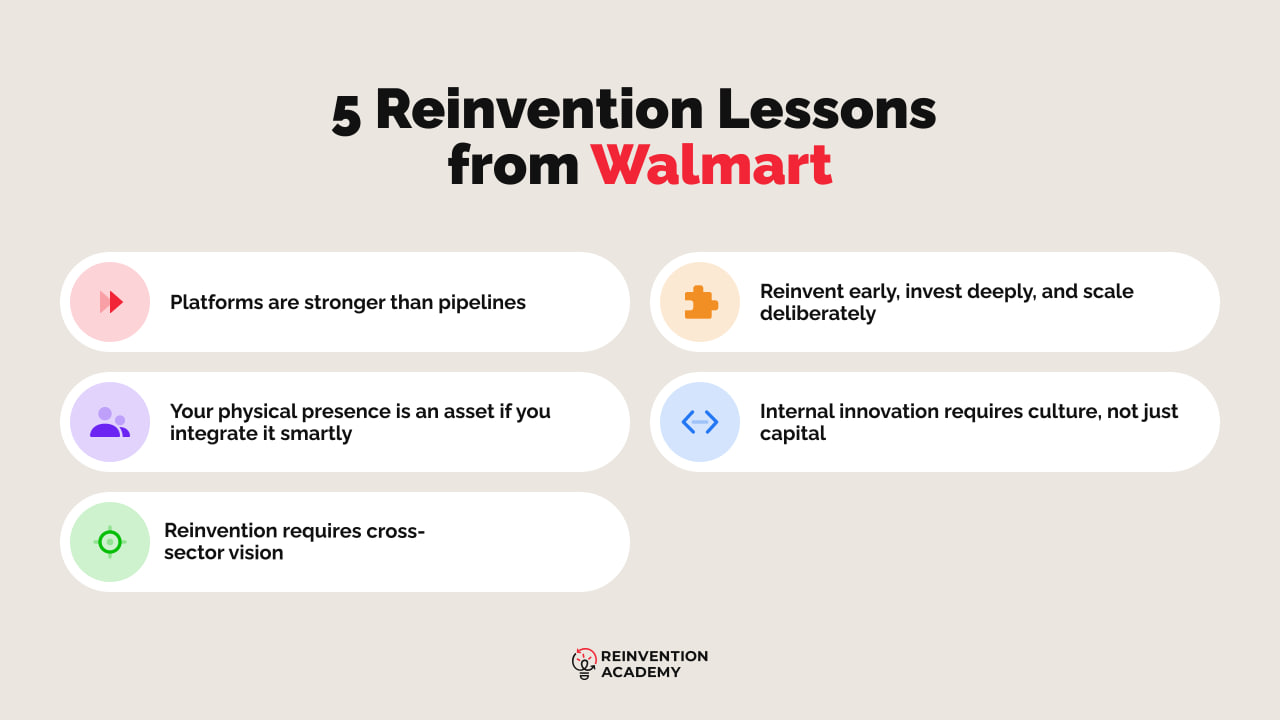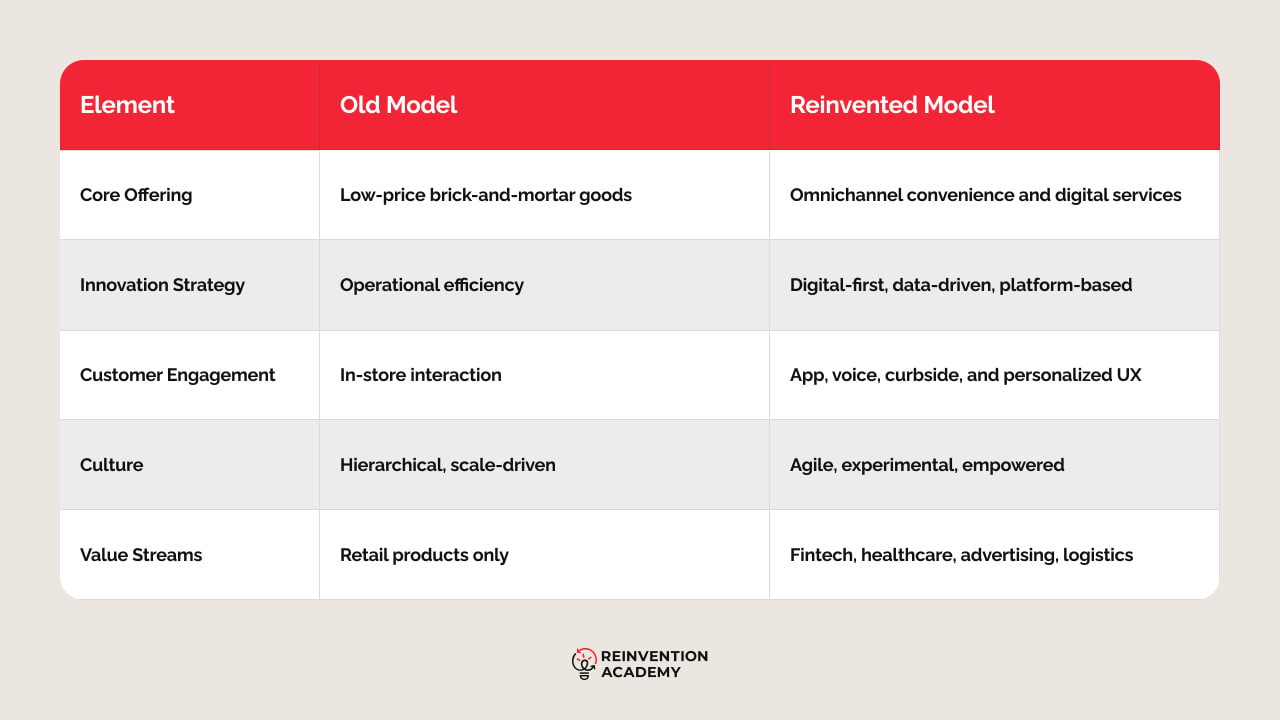How Walmart Reinvented Retail: From Big-Box Giant to Digital Ecosystem Leader
Discover how Walmart transformed itself from struggling with messy warehouses and falling sales to becoming a leader in AI-driven logistics and digital markets.

Under CEO Doug McMillon, who began his career loading trucks in the 1980s, the retail giant redefined its approach to compete with Amazon. By combining its extensive physical presence with e-commerce, data, and innovative strategies, Walmart has become a prime example of Dr. Nadya Zhexembayeva’s concept of continuous reinvention: letting go of outdated models, aligning with customer lifestyles, and instilling agility throughout its operations.
Why Walmart Needed Reinvention
Walmart’s wake-up call came in the form of multiple disruptions:
- E-commerce disruption: Amazon’s rapid growth was eroding Walmart’s dominance, especially in urban markets and tech-savvy demographics.
- Consumer behavior shifts: Shoppers began prioritizing convenience, speed, personalization, and ethical supply chains.
- Internal stagnation: Walmart’s massive scale had made it slower to adapt. Its legacy systems and culture weren’t built for digital agility.
The company was still profitable—but cracks were beginning to show. The retail landscape had changed, and Walmart had to do more than optimize its stores. It had to reinvent how it created and delivered value.
Walmart’s Reinvention Strategy
Walmart’s reinvention efforts focused on four major pillars:
1. Compete in E-commerce Like a Tech Company
Walmart invested billions in its digital infrastructure. Key moves included:
- Acquiring Jet.com to absorb e-commerce talent and tech.
- Launching a robust online marketplace to compete with Amazon.
- Offering curbside pickup and same-day delivery for groceries.
- Building in-house tech teams to reduce reliance on third-party vendors.
Walmart didn’t just want to be a retailer with a website—it wanted to think and operate like a tech company.
2. Leverage Physical Assets in New Ways
Instead of abandoning its brick-and-mortar presence, Walmart transformed stores into competitive advantages:
- Micro-fulfillment centers: Stores became local hubs for online order fulfillment.
- Click-and-collect services: Customers could order online and pick up in person—blending convenience with cost savings.
- Health clinics and financial services: Walmart added new service lines to drive foot traffic and community engagement.
This strategy turned a perceived liability (big stores) into a unique hybrid model.
3. Invest in Culture and Talent for Agility
Walmart realized that reinvention wasn’t just about tech—it was about people.
- It launched internal innovation labs to test and scale ideas quickly.
- The company restructured its leadership to prioritize cross-functional collaboration.
- Employee training was revamped to build digital literacy across all levels.
4. Expand into New Business Models
Rather than sticking to retail alone, Walmart began experimenting with:
- Advertising: Monetizing its shopper data through Walmart Connect.
- Financial tech: Investing in neobanking services for underbanked customers.
- Subscription models: Competing with Amazon Prime through Walmart+.
Each move reflected a willingness to rethink how Walmart makes money—not just how it sells products.
Two Enablers That Powered Walmart’s Reinvention
Walmart's evolution from a conventional big-box retailer to a tech-forward platform is rooted in a significant internal mindset shift and a strategic focus on external collaborations. Two key elements, cultural transformation and ecosystem partnerships, form the bedrock of Walmart's reinvention.
1. Culture Shift Toward Innovation
The company implemented innovation accelerators, established internal tech hubs, and formed cross-functional pilot groups that functioned with the agility of startups. These efforts enabled Walmart to trial features such as Scan & Go, autonomous delivery initiatives, and dynamic pricing models before rolling them out at scale.
At the store level, training in digital skills empowered associates to utilize real-time dashboards, mobile inventory systems, and predictive stocking tools, transforming each store into a center of digital intelligence. This shift to agile decision-making replaced centralized bottlenecks, enhancing speed and adaptability across operations.
Ultimately, this cultural transformation has allowed Walmart not only to adopt technology but also to integrate, operationalize, and scale innovation, a crucial factor in competing in the Amazon-dominated landscape.
2. Ecosystem Partnerships and Acquisitions
Alongside its internal transformation, Walmart also strategically positioned itself by partnering with and acquiring companies that bolstered its capabilities and filled significant innovation gaps. The $3.3 billion purchase of Jet.com in 2016 brought in e-commerce expertise and advanced technological infrastructure. Collaborating with Shopify broadened Walmart's network of third-party sellers, simplifying access for independent merchants to its platform. Partnerships with Microsoft enhanced cloud intelligence, while collaborations with IBM and logistics startups such as DroneUp and Cruise pushed the limits of supply chain automation and delivery speed.
These strategic alliances enabled Walmart to compete with Amazon on multiple fronts beyond just pricing. In 2024, Walmart's overall revenue reached around $680 billion, surpassing Amazon's $638 billion. Additionally, Walmart's emphasis on integrating services like GoLocal (for last-mile logistics), health clinics, and embedded financial technology reflects its growth into a more extensive digital ecosystem beyond mere retail.
In summary, Walmart’s internal cultural evolution and its strategic ecosystem partnerships embody a critical lesson from Dr. Nadya Zhexembayeva’s philosophy on reinvention: for lasting change, an organization must undergo internal restructuring and acquire external intelligence. Walmart's achievement comes from successfully executing both strategies on a large scale.

Dr. Nadya Zhexembayeva’s Reinvention Lens on Walmart
Walmart’s transformation serves as an exemplary model for how a traditional business can embrace agility and innovation while staying true to its core. Once primarily recognized as a physical retail powerhouse, Walmart has evolved into a dynamic ecosystem that links consumers, employees, suppliers, and developers through data-driven solutions, convenience, and intelligent services.
Instead of just reacting to market changes, Walmart has actively discarded outdated retail norms and:
- Reimagined itself to align with the modern consumer experience, encompassing both in-store and online interactions.
- Integrated continuous reinvention into its infrastructure, culture, and partnerships.
- Developed intelligent, responsive systems powered by AI that enhance every level of engagement.
- Introduced “super agents” to unify and enhance AI interactions across all touchpoints, including customers, employees, suppliers, and developers.
These AI-driven “super agents” signify the next advancement in Walmart’s platform approach. With tools like Sparky for customers, an upcoming Associate agent for employees, and Marty for third-party sellers and advertisers, Walmart is reshaping engagement through agentic AI, streamlining tasks like returns, reordering, event management, and internal processes.
As Dr. Nadya Zhexembayeva states, “Walmart didn’t just upgrade retail—it reengineered how value is created in a digital economy.”
5 Reinvention Lessons from Walmart for Business Leaders
- Your physical presence is an asset if you integrate it smartly. Walmart didn’t abandon its stores; it transformed them. By turning over 4,700 locations into mini fulfillment hubs, it used its existing footprint to reduce delivery times and costs, outpacing pure-play e-commerce rivals.
- Internal innovation requires culture, not just capital. Walmart invested not just in technology but in changing how employees think and operate. Innovation labs, agile pilots, and tech training turned legacy workflows into testbeds for digital transformation.
- Platforms are stronger than pipelines. Think ecosystem, not supply chain. Walmart evolved beyond a retail pipeline to build a platform. With Walmart Connect, fintech ventures, and healthcare services, it monetizes attention, not just transactions.
- Reinvention requires cross-sector vision. Walmart’s future is not just retail. Its expansion into health, finance, logistics, and advertising shows how reinvention thrives when leaders think beyond their traditional category.
- Reinvent early, invest deeply, and scale deliberately. Walmart didn’t wait for a decline to pivot. It made billion-dollar acquisitions like Jet.com early, layered innovation gradually, and scaled strategically to prepare for the next decade, not just the next quarter.
Walmart Reinvention at a Glance

Final Aisle: Why Walmart’s Reinvention Still Leads
Walmart’s evolution challenges the notion that being a large, established company hinders innovation. In fact, it demonstrates that when scale is combined with flexibility, it becomes a significant advantage. By discarding old beliefs, adopting a platform-oriented approach, and integrating intelligence throughout its operations, Walmart has transformed itself into not just a contemporary retailer but an advanced enterprise.
For today’s leaders, the critical question is no longer if reinvention is needed but if it is already overdue. Reflect on these questions:
- Where is your organization still adhering to outdated 1990s thinking?
- What new services could you provide that your customers are beginning to expect?
Walmart excels not because it was the first to act but because it acted purposefully, built capabilities progressively, and remained consistently focused on the customer. In the platform age, that is the only path that truly matters.


.svg)